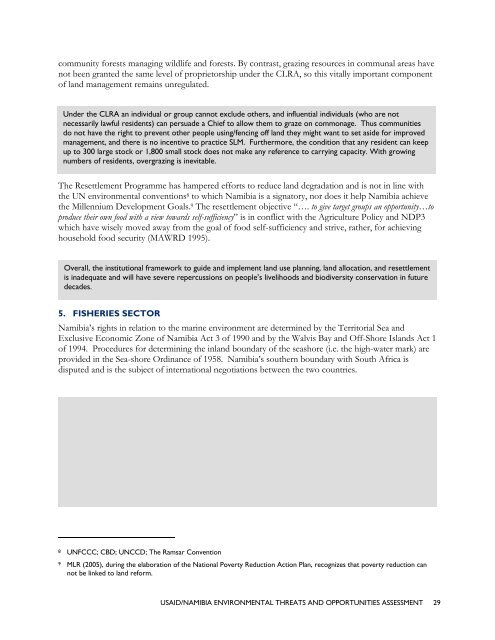usaid/nambia environmental threats and opportunities assessment
usaid/nambia environmental threats and opportunities assessment
usaid/nambia environmental threats and opportunities assessment
You also want an ePaper? Increase the reach of your titles
YUMPU automatically turns print PDFs into web optimized ePapers that Google loves.
community forests managing wildlife <strong>and</strong> forests. By contrast, grazing resources in communal areas have<br />
not been granted the same level of proprietorship under the CLRA, so this vitally important component<br />
of l<strong>and</strong> management remains unregulated.<br />
Under the CLRA an individual or group cannot exclude others, <strong>and</strong> influential individuals (who are not<br />
necessarily lawful residents) can persuade a Chief to allow them to graze on commonage. Thus communities<br />
do not have the right to prevent other people using/fencing off l<strong>and</strong> they might want to set aside for improved<br />
management, <strong>and</strong> there is no incentive to practice SLM. Furthermore, the condition that any resident can keep<br />
up to 300 large stock or 1,800 small stock does not make any reference to carrying capacity. With growing<br />
numbers of residents, overgrazing is inevitable.<br />
The Resettlement Programme has hampered efforts to reduce l<strong>and</strong> degradation <strong>and</strong> is not in line with<br />
the UN <strong>environmental</strong> conventions 8 to which Namibia is a signatory, nor does it help Namibia achieve<br />
the Millennium Development Goals. 9 The resettlement objective “…. to give target groups an opportunity…to<br />
produce their own food with a view towards self-sufficiency” is in conflict with the Agriculture Policy <strong>and</strong> NDP3<br />
which have wisely moved away from the goal of food self-sufficiency <strong>and</strong> strive, rather, for achieving<br />
household food security (MAWRD 1995).<br />
Overall, the institutional framework to guide <strong>and</strong> implement l<strong>and</strong> use planning, l<strong>and</strong> allocation, <strong>and</strong> resettlement<br />
is inadequate <strong>and</strong> will have severe repercussions on people’s livelihoods <strong>and</strong> biodiversity conservation in future<br />
decades.<br />
5. FISHERIES SECTOR<br />
Namibia’s rights in relation to the marine environment are determined by the Territorial Sea <strong>and</strong><br />
Exclusive Economic Zone of Namibia Act 3 of 1990 <strong>and</strong> by the Walvis Bay <strong>and</strong> Off-Shore Isl<strong>and</strong>s Act 1<br />
of 1994. Procedures for determining the inl<strong>and</strong> boundary of the seashore (i.e. the high-water mark) are<br />
provided in the Sea-shore Ordinance of 1958. Namibia’s southern boundary with South Africa is<br />
disputed <strong>and</strong> is the subject of international negotiations between the two countries.<br />
8 UNFCCC; CBD; UNCCD; The Ramsar Convention<br />
9 MLR (2005), during the elaboration of the National Poverty Reduction Action Plan, recognizes that poverty reduction can<br />
not be linked to l<strong>and</strong> reform.<br />
USAID/NAMIBIA ENVIRONMENTAL THREATS AND OPPORTUNITIES ASSESSMENT 29

















